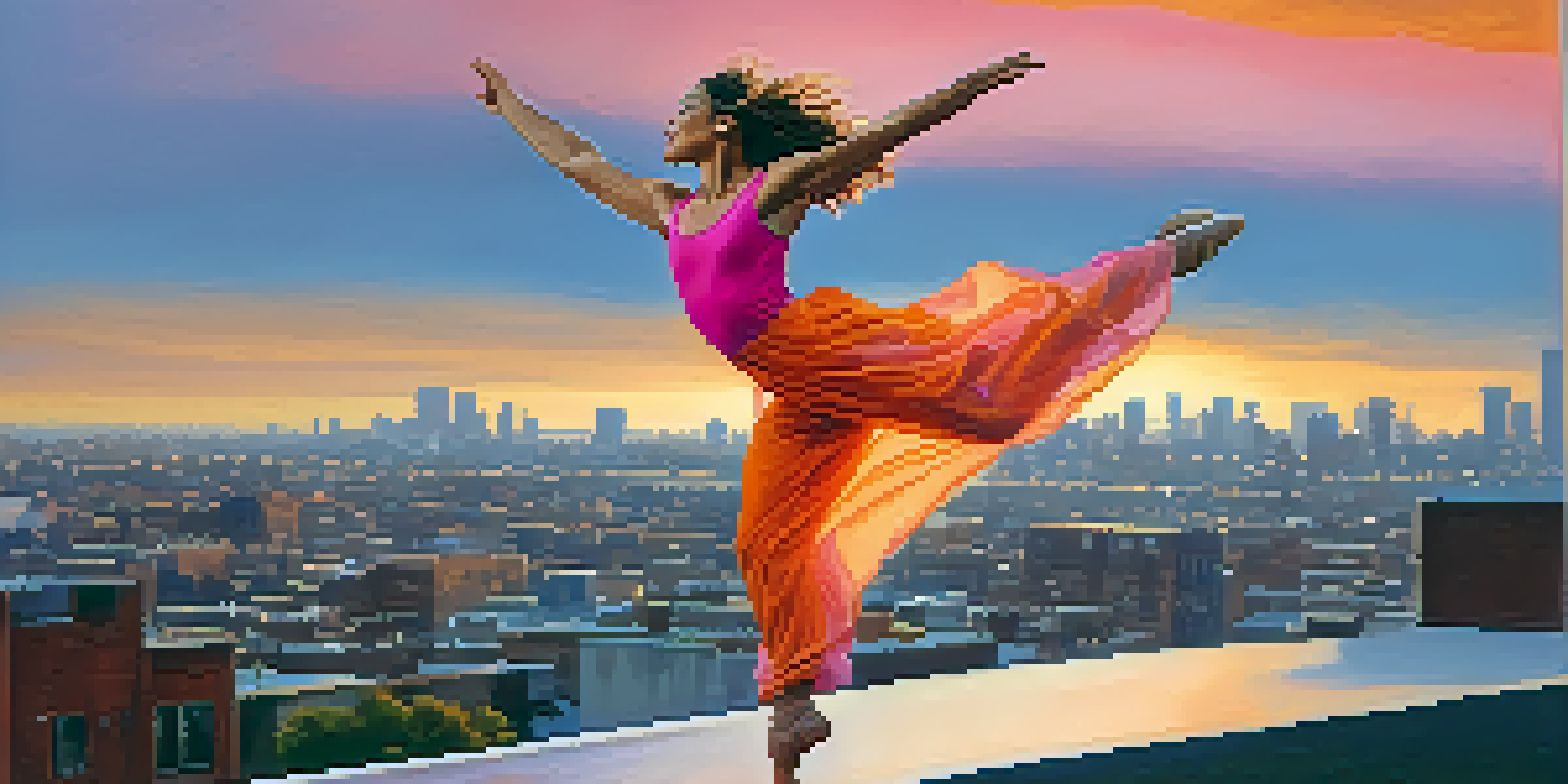Body Language in Dance: Communicating Feelings and Ideas

The Essence of Body Language in Dance
Body language in dance is not just about movement; it's about expression. Each gesture, posture, and nuance conveys emotions that words sometimes cannot. Dancers use their bodies as instruments to communicate their inner feelings, creating a dialogue that can resonate deeply with audiences.
Dance is the hidden language of the soul.
Consider how a simple arm movement can signify joy or sadness, depending on its speed and fluidity. A dancer might leap into the air with exuberance or fall to the ground in despair, transforming their physical form into a storyteller. Through these movements, they invite viewers to connect with their emotional landscape.
This non-verbal communication enriches the art form, allowing audiences to experience complex narratives. Just as a painter uses colors to evoke feelings, dancers use their bodies to paint emotions in motion, making body language an essential component of dance.
Cultural Influences on Dance Movements
Different cultures bring unique body language to their dance styles, enriching the global tapestry of movement. For instance, traditional African dances often incorporate vibrant and energetic movements that celebrate community and life, while ballet emphasizes grace and precision, reflecting European aesthetics.

These cultural variations influence how feelings are expressed through dance. A flamenco dancer's fierce footwork and sharp arm movements might communicate passion and strength, while a soft waltz captures the essence of romance and elegance. Each style offers a distinct emotional palette.
Dance Expresses Emotions Non-Verbally
Body language in dance transforms movements into emotional expressions that resonate with audiences.
Understanding these cultural contexts enhances our appreciation of dance. It reminds us that body language is not universally interpreted; it is layered with meaning shaped by history, tradition, and social norms.
Facial Expressions: The Silent Partner
Facial expressions play a crucial role in conveying emotions in dance. A dancer's face can express joy, anger, or sadness, adding depth to their performance. When a dancer smiles while executing a difficult move, it enhances the feeling of joy, making the audience feel that emotion too.
The body says what words cannot.
For example, in contemporary dance, a furrowed brow or a quivering lip can communicate internal conflict, drawing the audience into the dancer's emotional struggle. This connection is powerful; it transforms a performance from mere movement into an emotional experience.
Thus, facial expressions serve as a silent partner to body language, amplifying the message being conveyed. When combined, they create a fuller, more engaging narrative that resonates with viewers on a personal level.
The Role of Space and Proximity in Dance
Space and proximity are vital components of body language in dance. The distance between dancers can convey intimacy or tension; for instance, close proximity often signifies connection or affection, while greater distances might indicate conflict or isolation. This spatial dynamic adds another layer to the storytelling.
In a duet, the way dancers navigate space can reflect their relationship. If they frequently mirror each other, it suggests harmony; if they move apart, it may symbolize emotional distance. This interplay invites the audience to interpret the relationship beyond the movements themselves.
Cultural Context Shapes Dance Styles
Different cultures influence dance movements, enriching the emotional communication through unique body language.
Thus, understanding how space influences body language enhances our experience of dance. It encourages us to look beyond the choreography and grasp the subtle emotional currents flowing between the dancers.
Movement Quality: Conveying Emotion Through Style
Movement quality refers to the characteristics of how a dancer executes their movements. It can range from sharp and staccato to fluid and languid, each style evoking different emotions. For instance, sharp movements might express anger or urgency, while smooth, flowing movements can convey peace or tranquility.
Consider a contemporary piece where a dancer transitions from rigid, quick movements to soft, flowing gestures. This change can symbolize a journey from conflict to resolution, allowing the audience to feel the transformation emotionally. The quality of movement acts as a bridge between physical expression and emotional interpretation.
Therefore, movement quality is essential in dance, as it shapes how feelings are communicated. Dancers harness this quality to create impactful performances that resonate with their audience on a deeper level.
Improvisation: Spontaneous Emotional Expression
Improvisation in dance allows for spontaneous emotional expression, breaking free from structured choreography. This freedom encourages dancers to let their feelings guide their movements, resulting in a raw and authentic performance. Often, the most powerful moments in dance arise from improvisational sections.
For example, a dancer might feel a wave of sadness and begin to move in a way that reflects that emotion, creating a visceral connection with the audience. This unpredictability can draw viewers in, making them feel like they are witnessing something truly unique and personal.
Audience Perception Influences Meaning
Each viewer's personal experiences shape their interpretation of a dancer's body language, creating a shared emotional experience.
Ultimately, improvisation highlights the organic nature of body language in dance. It emphasizes that emotions can be fleeting and complex, and dance serves as a beautiful medium to capture these moments in time.
The Impact of Audience Perception on Dance Communication
Audience perception plays a significant role in how body language in dance is interpreted. Each viewer brings their experiences and emotions, shaping their understanding of the performance. A dancer's expression might resonate differently with one person compared to another, creating a rich tapestry of interpretations.
For instance, a work that explores themes of loss might evoke deep sadness in one audience member while inspiring hope in another. This variance enriches the experience, as the dancer's body language serves as a catalyst for personal reflection.

Therefore, the connection between a dancer and their audience is reciprocal. While dancers communicate through movement, the audience's reactions and feelings can influence the overall impact of the performance, making body language a shared experience.